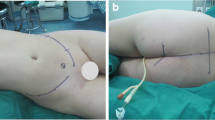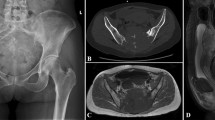Abstract
Primary sacral tumor is rare, for which surgical resection is the cornerstone of therapy [1, 2]. For primary sacral malignancies involving the upper sacrum, the main treatment is total en bloc sacrectomy (TES). Although the functional outcome of TES-treated patients without spinopelvic reconstruction has been reported as acceptable [3], the bone defect resulting from TES which leads to the discontinuity between spine and pelvis often requires reconstruction because of the facilitation for early mobilization which precludes the complications in patients who are bedridden for a long time [4]. According to the classification proposed by Bederman et al., the reconstruction methods after TES can be categorized into three types: spinal pelvic fixation (SPF), posterior pelvic ring fixation (PPRF), and anterior spinal column fixation (ASCF) [5]. It was suggested that a combined reconstruction including ASCF would be the optimal reconstructive method after TES [5]. However, the combined reconstruction including ASCF conceivably has an increased risk of prolonged surgical time and massive intraoperative hemorrhage, which would impair the safety of the procedure. To address this problem, several unconventional reconstruction methods aiming at synthesizing SPF/SPF+PPRF and ASCF, such as reimplantation of extra-corporeally irradiated sacrum and endoprosthesis replacement, had been reported [6, 7], which, however, could hardly show advantages over another due to the limited number of cases. In general, the standardized reconstructive method for TES-treated patients remains controversial.
Access this chapter
Tax calculation will be finalised at checkout
Purchases are for personal use only
Similar content being viewed by others
References
Sciubba DM, Petteys RJ, Garces-Ambrossi GL, et al. Diagnosis and management of sacral tumors. J Neurosurg Spine. 2009;10(3):244–56.
Li D, Guo W, Tang X, et al. Surgical classification of different types of en bloc resection for primary malignant sacral tumors. Eur Spine J. 2011;20(12):2275–81.
Kiatisevi P, Piyaskulkaew C, Kunakornsawat S, et al. What are the functional outcomes after total Sacrectomy without Spinopelvic reconstruction? Clin Orthop Relat Res. 2017;475(3):643–55.
Wuisman P, Lieshout O, Sugihara S, et al. Total sacrectomy and reconstruction: oncologic and functional outcome. Clin Orthop Relat Res. 2000;381:192–203.
Bederman SS, Shah KN, Hassan JM, et al. Surgical techniques for spinopelvic reconstruction following total sacrectomy: a systematic review. Eur Spine J. 2014;23(2):305–19.
Nishizawa K, Mori K, Saruhashi Y, et al. Long-term clinical outcome of sacral chondrosarcoma treated by total en bloc sacrectomy and reconstruction of lumbosacral and pelvic ring using intraoperative extracorporeal irradiated autologous tumor-bearing sacrum: a case report with 10 years follow-up. Spine J. 2014;14(5):e1–8.
Wuisman P, Lieshout O, van Dijk M, et al. Reconstruction after total en bloc sacrectomy for osteosarcoma using a custom-made prosthesis: a technical note. Spine. 2001;26(4):431–9.
Wei R, Guo W, Ji T, et al. One-step reconstruction with a 3D-printed, custom-made prosthesis after total en bloc sacrectomy: a technical note. Eur Spine J. 2017;26(7):1902–9.
Shah FA, Omar O, Suska F, et al. Long-term osseointegration of 3D printed CoCr constructs with an interconnected open-pore architecture prepared by electron beam melting. Acta Biomater. 2016;36:296–309.
Shah FA, Snis A, Matic A, et al. 3D printed Ti6Al4V implant surface promotes bone maturation and retains a higher density of less aged osteocytes at the bone-implant interface. Acta Biomater. 2016;30:357–67.
MacBarb RF, Lindsey DP, Bahney CS, et al. Fortifying the bone-implant Interface part 1: an in vitro evaluation of 3D-printed and TPS porous surfaces. Int J Spine Surg. 2017;11:15.
Huang L, Guo W, Yang R, et al. Proposed scoring system for evaluating neurologic deficit after sacral resection: functional outcomes of 170 consecutive patients. Spine. 2016;41(7):628–37.
Author information
Authors and Affiliations
Editor information
Editors and Affiliations
Rights and permissions
Copyright information
© 2020 Springer Nature B.V.
About this chapter
Cite this chapter
Guo, W. (2020). Using 3D Printing Sacral Endoprosthesis for Spinopelvic Reconstruction. In: Guo, W., Hornicek, F., Sim, F. (eds) Surgery of the Pelvic and Sacral Tumor. Springer, Dordrecht. https://doi.org/10.1007/978-94-024-1945-0_28
Download citation
DOI: https://doi.org/10.1007/978-94-024-1945-0_28
Published:
Publisher Name: Springer, Dordrecht
Print ISBN: 978-94-024-1943-6
Online ISBN: 978-94-024-1945-0
eBook Packages: MedicineMedicine (R0)




